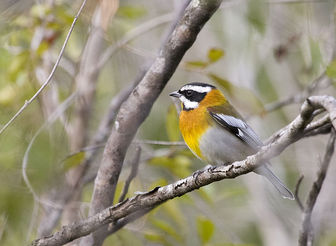Stripe-headed Tanager
The spindalises were traditionally considered aberrant tanager of the family Thraupidae, but actually they do not seem to belong there. Like the equally enigmatic Bananaquit , they belong to superfamily Passeroidea, wherein they are provisionally treated as incertae sedis among the nine-primaried oscines

Original source: Laura Gooch
Author: Laura Gooch
The Stripe-headed Tanager is classified as Least Concern. Does not qualify for a more at risk category. Widespread and abundant taxa are included in this category.
previous name of Stripe-headed Tanager at least gave us some idea of what to expect… Unfortunately for birders who like their bird-names simple and descriptive, the Stripe-headed Tanager turned out not to be a single variable endemic Caribbean species, but a group of four closely-related taxa that - based on distribution, differences in calls and the complexity of songs*, and differences in the plumages of both males and females - are in fact four endemic Caribbean species that were subsequently named More
The Stripe-headed Tanager was renamed in 2000, the change announced to eager enthusiasts in the forty-second supplement to the American Ornithologists’ Union check-list of North American birds. Such revisions are well-attended by birders because each new supplement offers not just superficial alterations in nomenclature but also reorganization of the taxonomic chart and consolidation or division of certain species. More
Stripe-headed Tanager was first described by Lineaus in 1758 and was called "The Bahama Finch" in the Natural History of Carolina by Catesby. It was the striking differences in the plumages of the females, as well as vocalization differences, that led ornithologists to split Stripe-headed Tanager into Western Spindalis, the endemic Hispaniolan Spindalis (S. dominicensis) of the Dominican Republic and Haiti, the Puerto Rican Spindalis (S. portoricensis) of Puerto Rico, and the Jamaican Spindalis (S. nigricephala) from Jamaica. More
Formerly a single species, Stripe-headed Tanager, was split into four in 2000 with Western Spindalis the only spindalis recorded, so far, in the ABA Area. The genus Spindalis is restricted to the West Indies and may be related to the Thraupis tanagers, which they resemble in plumage and feather structure. Western Spindalis is currently the only ABA species member of the tropical tanager family. The Piranga tanagers were moved to the cardinal family in 2009. More
Stripe-headed Tanager, is a songbird species. In the past, the taxon S. zena was loosely circumscribed, lumping all other spindalises into it. The spindalises were traditionally considered aberrant tanager of the family Thraupidae, but actually they do not seem to belong there. More
Stripe-headed Tanager (Spindalis zena - Western Spindalis) Summer Tanager (Piranga rubra) Swallow Tanager (Tersina viridis) Tawny-capped Euphonia (Euphonia anneae)Blue-grey Tanager, Thraupis episcopus Tawny-crested Tanager (Tachyphonus delatrii) Turquoise Tanager (Tangara mexicana) Thick-billed Euphonia (Euphonia laniirostris) Violaceous Euphonia (Euphon a violacea) Western Spindalis (formerly referred to as Stripe-headed Tanager) Western Stripe-headed Tanager (Western Spindalis) Western Tanager, Piranga ludoviciana White-capped Tanager (Sericossypha More
Stripe-headed Tanager Spindalis zena = * Home Expand Log in Menu item Register Menu item Log out Menu item Change login details Menu item Why register? Expand UK & Ireland Menu item Birding sites More
Northern Stripe-Headed Tanager, Porto Rican Spindalis, Stripe-Headed Tanager, Western Spindalis Common Names in French: Tangara à Tête Rayée Common Names in German: Streifenkopftangare Common Names in Japanese: シトドフウキンチョウ Common Names in Spanish: T�ngara Cabeza Rayada, Tángara Cabeza Rayada Common Names in unspecified: Stripe-Headed Tanager Description - More
Family : Thraupidae
Genus : Spindalis
Species : zena
Authority : (Linnaeus, 1766)

